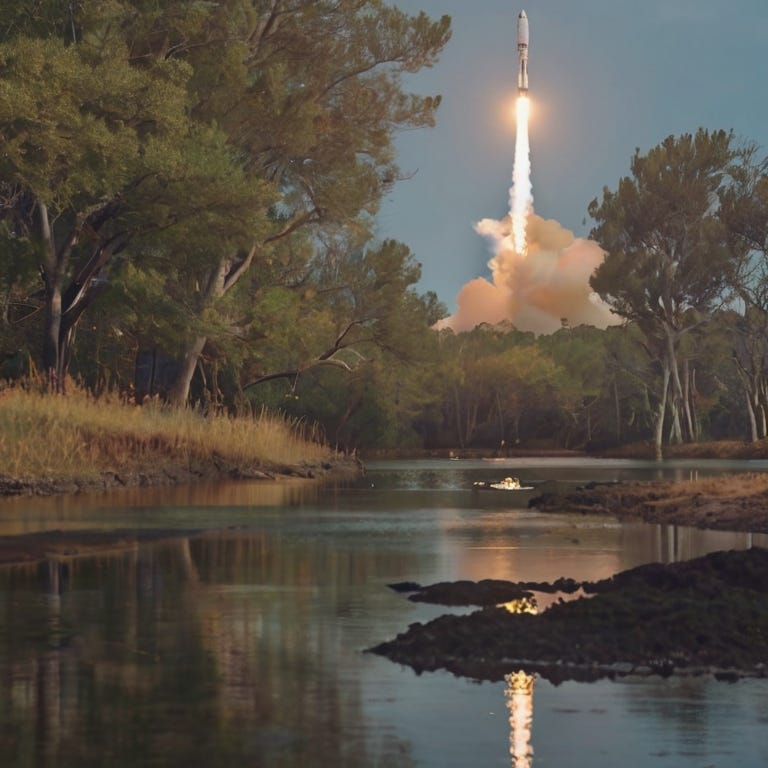Not all visions of environmental protection describe a hell on Earth. Not all predictions of our shared future are quite so devoted to terrifying people into submission. I would expect that many are tiring of the endless doom, and would welcome a more optimistic vision. A happy end to the story.
I am an engineer, and my entire life has been devoted to solving problems. To do so requires a certain positivity that one can indeed solve the problem, and so I am inclined to join the ranks of the optimistic.
Surrendering to despair and sitting in the road is simply not conducive to problem solving, and the best solutions are those fought from an intractable paradox.
Such optimism in the protection of the environment can be found in the solarpunk movement. Solarpunk is an art and literary genre that imagines a future in which society has advanced in a sustainable and environmentally friendly manner. It often portrays communities that prioritize renewable energy sources like solar power, wind power, and other eco-friendly technologies.
Solarpunk art and stories emphasize community resilience, social justice, ecological harmony, and the intersection of technology and nature. It offers a hopeful vision of the future where humanity works with the environment to create a better world.
But I’m not an artist.
I’m just an engineer.
However, I do prefer this optimistic vision over the endless doom we are currently fed. So, as an engineer I offer what I can to the genre. I try to imagine what practical technologies might actually realise a solarpunk future.
A solarpunk inspired illustration might depict a vibrant and lush urban landscape teeming with life and sustainable technology. Bustling streets are lined with greenery. Vertical gardens cascade down the sides of buildings. Trees flourish along sidewalks. Solar panels adorn rooftops, capturing the sun’s energy. Wind turbines spin gracefully in the distance, generating clean power for the city.
People stroll or ride bicycles along pedestrian-friendly paths. Parks and communal spaces are integrated throughout the cityscape, offering places for residents to gather, relax, and connect with nature. Community gardens thrive, providing fresh produce for local neighbourhoods. Rainwater collection systems and decentralized renewable energy sources ensure resilience and self-sufficiency.
Pastoral scenes that integrate rustic and advanced technologies are common in solarpunk. The images from a commercial ‘Dear Alice’ are often used to illustrate this solarpunk ideal.
This yoghurt commercial presents an idyllic pastoral scene in which advanced technologies are integrated into a farming environment.
Enormous windmills are suspended in the sky from balloons. Solar panels cover every roof. The manual labour of this farm is performed by robots. Extremely advanced technology causes rain to fall from the sky. A great shining city of glass rises to the sky amongst this rural paradise.
Art leads science, and vice versa. I appreciate that, and appreciate the inspiration this art movement offers to a mere engineer. If the solarpunk art movement hopes to encourage the development of those technologies required to realise this ideal, as an engineer I have questions.
Where do all those solar panels and batteries come from? Who builds them? From where are the exotic materials mined to create this technology? Whose country do we sacrifice to gather those materials? Who digs it from the earth? Who sweats over the vast kilns required to manufacture all that glass?
What’s holding up those wind turbine balloons? Who is collecting Helium from natural gas deposits? And how? If mighty towers are to loft great turbines into the skies, who works in the foundries required to construct them? Where is all that steel forged?
Who builds those robots? How is digital control and communication maintained? Are mobile phones and laptops a thing of the past? Is the internet at an end? Who maintains and repairs them? Where is all that silicone fabricated? Upon what processing power does all that AI run? Can we build a laptop by hand? Can you build an integrated chip at home?
The design and manufacture of these technologies are not a cottage industry. How does the vast global supply chain required to transport these raw materials and goods from all corners of the earth function? Is there an enormous industrial mechanism to efficiently manufacture all this technology in great numbers and at low cost? How are these advanced technologies delivered without a contribution from the huge corporations so often rejected by a solarpunk ideal?
Don’t forget all those people who must work in mining and heavy industry to build all those solar panels and wind turbines. These are complex technologies that demand exotic, complex manufacturing. Who works in these factories? Do they also get to live in a pastoral idyll?
Or do they live in some industrial estate?
Over the horizon?
Far away?
Out of sight.
If a solarpunk ideal represented not the environment of those naïve to how all this technology came to be, but instead illustrated the lives of those who laboured to construct it, would this illustrated world be quite so idyllic?
I can appreciate that an art movement will employ a vision of future technology as technology is currently understood. Plastics, glass, electronics, battery power, information technologies, computer processors, robots. All of these are standard features of a futuristic vision.
However, if solarpunk hopes to illustrate a future in which technology works in harmony with nature, and is manufactured in a decentralised manner, the sleek and advanced technologies typically illustrated in a solarpunk ideal aren’t it.
A solarpunk vision works in isolation only if we ignore the infrastructure and workforce required to construct it. Otherwise, a crisp gleaming future all watched over by machines of loving grace is not a sustainable future for all. It’s a playground for the privileged.
An example of this playground can be found in the popular trope of the digital nomad who employs telecommunications technologies to earn a living and conduct their life. This allows the nomad to travel and work from anywhere in the world where they have access to a reliable internet connection. Digital nomads often choose this lifestyle for its flexibility, allowing them to explore new places, experience different cultures, and maintain a work-life balance that suits their preferences.
Digital nomads often embrace a minimalist lifestyle, as they need to be mobile and flexible. They may travel with only essential belongings, relying on coworking spaces, cafes, or even dedicated digital nomad hubs in different cities around the world for their workspace needs.
This creates the illusion of sustainability.
Consider the technological infrastructure required to keep this individual well fed, on the road and connected to the world. Consider the array of satellites overhead, guiding and informing the information technologies that may be integrated into a van or a bicycle that sprouts solar panels and satellite dishes. Where is all this technology coming from?
To realise a decentralised, resilient and self-sufficient manufacturing system, technologies must be accessible, repairable, constructed from materials found locally and constructed using tools to hand.
Technology would not be corporate nor homogenous. Each would reflect the skills and the materials and the terrain in which they function. Low tech. Small tech.
Technology would exhibit a local flair.
Wood, steel, fabrics, nuts and bolts would offer technology that can be assembled, dismantled, reassembled, reused and repurposed for many years. Technology would not be disposed of when no longer functioning, so must be easily transformed into something new. Complex digital control may be recovered and reused from local junk, as its unlikely to be built from scratch. Technology would last many lifetimes. Machines would bear the dents and scars from the maintenance offered by your parents, or from your grandparents. Planned obsolescence would be a thing of the past.
Fashion cycles and the pace of technological change may slow. The past would be valued. The lives of our children may be very much like the lives of their grandparents. Human labour would return as a prime mover. Human ingenuity, a local resource. Technology would be handmade.
Unless we consign some to working in great factories or digging in deep mines for exotic materials, the solarpunk ideal won’t be covered in solar panels, laptops, mobile phones and internet connectivity.
To realise a solarpunk ideal, the future may begin to look very much like the past.
Illustrate that, and perhaps we can build it.
Could Victorian technologies save the world?
To think of 19th century industrial power is to imagine dark smoke spewing from a forest of tall chimneys to choke the air from the pitiful workers below and smear their lives with an oily residue. A coal and oil fuelled environmental nightmare that one might hope to consign to history, but persists today.
I want to believe in electric cars.
I really wanted to love electric vehicles, but this technology does not make it very easy. My professional specialism is to understand and promote the exploitation of new technology. I spend my days understanding the benefits, identifying the harms that accompany these benefits and trying to separate the two.











